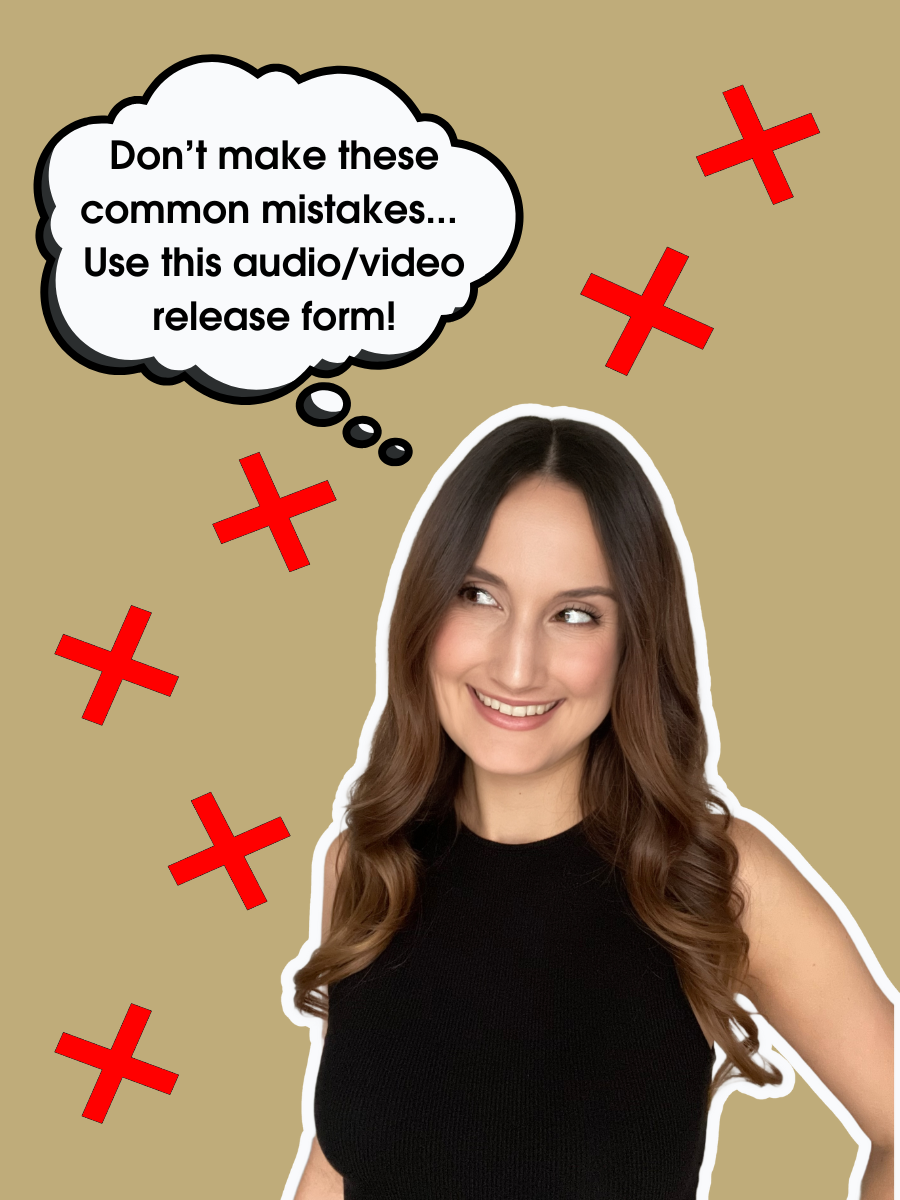10 Major Mistakes to Avoid in an Audio/Video Release Form (& How to Fix Them Before You Publish a Thing)
Ever poured your heart into recording something amazing, only to have someone demand you take it down — because your audio/video release form didn’t cover all the bases?
Creating audio or video content takes time, money, and a ton of creative energy. The last thing you want is a legal roadblock forcing you to edit, remove, or even scrap your project altogether.
As a lawyer who drafts and reviews release forms for all kinds of media, I’ve seen too many creators lose hard-earned work (and revenue) over avoidable mistakes.
In this post, I’ll walk you through the 10 biggest mistakes to avoid in your audio/video release form — plus exactly how to fix them in your audio/video release form template, so you can publish and profit from your content with confidence, knowing you have an ironclad and fluff free audio/video release form.
And if you’d rather skip the trial-and-error? My Audio/Video Release Form Template already has every essential clause built in, so you can protect your work from day one.
This post is all about the key mistakes to avoid in an audio/video release form to avoid major issues.
Fundamental Audio/Video Release Form
The 10 Common Mistakes to Avoid in Your Audio/Video Release Form Template
1. Ambiguous Language That Leaves Too Much Open to Interpretation
It might feel smart to keep your release form super broad — “worldwide,” “perpetual,” “all media” — so you can use the recording anywhere, anytime. But vague, one-line permissions can actually backfire.
If the person you recorded later dislikes how or where you’ve used the content, they could claim you misled them. Even if you technically have the right, you could still end up in a legal dispute (or a PR nightmare).
Instead, be clear and specific in your audio/video release form. List the platforms and purposes you know you’ll use — for example: “YouTube, TikTok, Apple Podcasts, and future marketing campaigns.” You’ll still protect your flexibility, but you’ll avoid misunderstandings that can lead to takedown demands.
💡 Want plug-and-play wording that’s clear, comprehensive, and dispute-proof? My Audio/Video Release Form Template already has it.
2. Skipping a Clear Waiver of Personality Rights
Every person has personality rights — like the right to control the commercial use of their name, image, and voice. Even if your country or state allows recording someone without their consent, they can still sue you if your published content harms their reputation, privacy, or brand.
And don’t assume that showing up to your shoot equals permission. Without explicit, written consent waiving these rights in your audio/video release form, you’re leaving the door wide open to future disputes.
The safest route? Get the form signed before you hit “record.” Make sure your video release form pdf clearly states you have permission to use their name, image, and voice in your final product, across the platforms you choose.
💡 Need airtight language that covers all personality rights — so no one can pull the plug on your project later? It’s already built into my Audio/Video Release Form Template.
3. Ignoring Intellectual Property Rights
Here’s a big one most creators overlook: the person you record may also hold copyright over the parts of the recording that feature them. That makes them a co-owner of your content — and gives them the power to demand edits, removal, or even block its use entirely.
If your audio or video release form doesn’t explicitly state whether those rights are assigned to you or licensed for your use, you risk copyright infringement claims down the line.
Protect yourself by including a clear clause that transfers or licenses all intellectual property rights in both the recording and its content to you. Without it, you’re one email away from losing the right to use your own project.
💡 Not sure how to word this without missing something critical? My Audio/Video Release Form Template includes bulletproof IP rights language you can drop straight in.
4. Leaving Compensation Terms Vague
Money disputes can get ugly — fast. If your release form doesn’t clearly state whether the person is being paid (and exactly how much), you’re inviting trouble.
Worse, without a clear “no further compensation” clause, they could demand royalties, residuals, or other payouts if your content goes viral or generates unexpected revenue. Imagine landing a sponsorship deal… only for the person in your video to claim they deserve a cut.
Your audio/video release form should spell out:
Whether they’re being paid at all
The exact amount, if applicable
That they’re never entitled to additional payment, now or in the future
💡 Want this clause done-for-you, with zero room for misunderstandings? It’s already in my Audio/Video Release Form Template.
5. Skipping Indemnity for Third-Party Rights
Even if you secure the person’s consent, their contribution could still infringe someone else’s rights — like quoting copyrighted material or using a phrase that belongs to another brand. If that happens, you could be the one facing the legal claim.
An indemnity clause protects you by requiring the recorded person to cover any damages, claims, or legal costs if their contribution violates a third party’s rights. Without it, you could end up paying the price for something you didn’t create.
Your audio/video release form should make it clear: If they cause the problem, they take responsibility for fixing it — not you.
💡 My Audio/Video Release Form Template already includes this exact protection, so you’re covered from all angles.
6. Allowing the Release to Be Revoked Later
Some release forms leave a dangerous loophole — they allow the person to revoke their consent later. This means you could be forced to pull your content months or even years after publishing, losing all the time, money, and credibility you invested.
Your audio/video release form should make the consent irrevocable and the rights perpetual. This ensures that once the agreement is signed, you can use the content indefinitely without worrying about someone changing their mind.
💡 Both versions of my Audio/Video Release Form Template include clear clauses making the grant of rights perpetual, worldwide, non-revocable, and royalty-free — so you never have to re-secure permission.
7. Forgetting to Cover Approval & Editing Rights
It’s common for people in your recording to expect control over how the final product looks or sounds — and without clear terms, they may demand edits or block publication entirely.
Your audio/video release form should explicitly waive the person’s right to approve, edit, or request changes to the final work. It should also grant you full rights to modify, adapt, and use the recording in any format or context you choose.
💡 My Audio/Video Release Form Template removes all approval rights and gives you complete creative control, so you can edit, repurpose, and publish without interference.
8. Overlooking Non-Disparagement Protection
Many release forms say nothing about how the person you recorded can speak about you or your business afterwards. Without a non-disparagement clause, they could publicly criticize your brand, products, or content in a way that damages your reputation — even if you’ve used the recording perfectly legally.
A strong audio/video release form should stop this at the source. It should clearly state that neither party can make unsubstantiated, harmful, or misleading statements about the other.
💡 My Audio/Video Release Form Template includes a built-in non-disparagement clause, so you’re protected from reputation-damaging comments after the recording is published.
9. Forgetting to Include Confidentiality Obligations
Some recordings involve sensitive information — like unreleased campaigns, behind-the-scenes business details, or personal data. If your release form doesn’t include a confidentiality clause, the person in your recording could legally share that information with others, putting you at risk.
Your audio/video release form should clearly define what counts as “confidential” and limit how that information can be used or shared.
💡 My Audio/Video Release Form Template has a robust confidentiality section that prevents sensitive details from being disclosed without your consent.
10. Not Requiring Guardian Consent for Minors
The last major mistake is not getting the parent’s or guardian’s convesnt when recording a minor.
If your recording features anyone under the legal age of consent in your country or state, you must have a parent or legal guardian sign the audio/video release form on their behalf.
Without it, the release is invalid — meaning you could be forced to remove the content or face legal action later.
Too many creators assume a verbal “okay” from a parent is enough, or that a minor can sign for themselves.
Legally, that’s not the case in most jurisdictions.
💡 My Media Release Form Template Bundle includes a template specifically for minors with a guardian consent section that makes the agreement binding for minors — and it’s written so the consent is indefinite and non-revocable.
The Ultimate Audio and Video Release Form Template Free of Fluff!
Every one of these mistakes can cost you far more than just frustration — they can mean lost revenue, damaged reputation, and even legal disputes. The good news? They’re all preventable when you have the right protections in your audio/video release form from the start.
Don’t gamble with your hard work. Get a professionally drafted, ready-to-use Audio/Video Release Form Template so you can:
Secure all the rights you need — permanently
Avoid takedown demands months or years later
Keep full creative control over your content
Protect yourself from copyright and third-party claims
Publish confidently, knowing you’re legally covered
🎯 Protect your content today — download your Audio/Video Release Form Template now → Get the Template Here
This post was all about the key mistakes to avoid in your audio/video release form for full protection of your rights.
To learn more about major mistakes to avoid and what you need in an audio/video release form, read these next blog posts:




